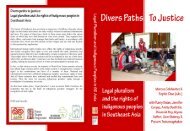The Upper Caura, Venezuela - Forest Peoples Programme
The Upper Caura, Venezuela - Forest Peoples Programme
The Upper Caura, Venezuela - Forest Peoples Programme
You also want an ePaper? Increase the reach of your titles
YUMPU automatically turns print PDFs into web optimized ePapers that Google loves.
Protecting and encouraging customary use of biological resources: <strong>The</strong> <strong>Upper</strong> <strong>Caura</strong>, <strong>Venezuela</strong>_________________________________________________________________________________________8 Towards Compliance with the CBD: reflections and recommendationsIn their relations with national policy makers today, the indigenous peoples of the <strong>Upper</strong><strong>Caura</strong> face a ‘Catch 22’ situation. On the one hand, national conservation agencies questionthe capacity of the indigenous peoples to manage the area sustainably and point to changesin their economic strategies and practices which, they claim, may jeopardise certain speciesor ecosystems. On the other hand, national development agencies question theappropriateness of conceding collective ownership to the indigenous peoples on thegrounds that it is too much land for so few people. In short, they are either damned for notusing the area enough or for using it too much!It is the conclusion of this study that the current and projected uses of the <strong>Upper</strong> <strong>Caura</strong> bythe indigenous inhabitants, which are based substantially on customary use and regulatedby traditional practices are compatible both with ‘sustainable use requirements’ and with‘conservation’. <strong>The</strong> indigenous peoples´ pressure on natural resources is slight and theyhave declared themselves keen to collaborate in the management of the protected areasthat have been established in their territories by decree.It is clear, moreover, that the communities have made a precedent-setting effort to ensuresound natural resource management in the area – defending the area against outsidethreats, building up their own management capacity and adopting new measures tomoderate the slight pressures that their own economies exert on local ecosystems. As suchthe <strong>Venezuela</strong>n State has an obligation to protect and encourage these uses and traditionalpractices in compliance with Article 10c of the Convention on Biological Diversity.Moreover, the new Constitution, the law on the demarcation of indigenous habitats and thelaw incorporating ILO Convention 169 into national law, already provide the legal basis forachieving this within the national legal framework.<strong>The</strong> following practical steps are therefore required to give effect to these laws. <strong>The</strong> National Commission on Indigenous Habitat and Land Demarcations shouldannounce that it has approved the <strong>Upper</strong> <strong>Caura</strong> land claim and formally pass thisendorsement to the Ministry of the Environment for confirmation. <strong>The</strong> Ministry of Environment should in turn approve this land claim and pass it tothe Procuraduría General de la República for issuance of collective title. This title should be issued in the name of the Öyaamö, the basinwide assembly ofYe´kwana and Sanema village leaders from the <strong>Upper</strong> <strong>Caura</strong>, to hold the land intrust for all the indigenous communities of the <strong>Upper</strong> <strong>Caura</strong>. In accordance with the law, this land title should be inalienable, unmortgageableand not subject to distraint. <strong>The</strong> title so issued should be registered in the national land cadaster. Steps should be taken to jointly develop co-management plans for the threeprotected areas in the <strong>Upper</strong> <strong>Caura</strong>, namely the Parque Nacional Jaua-Sarisariñama and the Monumentos Naturales Serranía de Maigualida and CerroIchún-Guanacoco.53
















